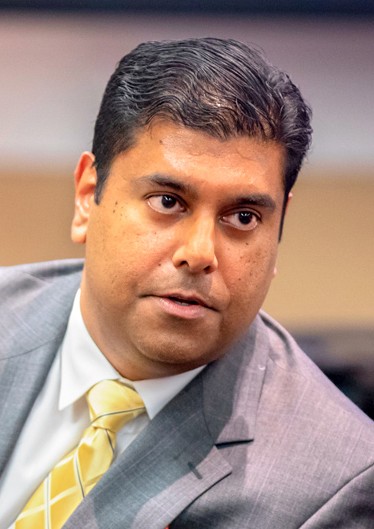Weill Cornell radiologist to lead enhanced MRI research facility
By Stephen D'Angelo
Leading a new era in magnetic resonance imaging research capabilities at Cornell, Dr. Sumit Narayan Niogi, assistant professor of radiology and clinical associate in radiology at Weill Cornell Medicine, has been named director of the Cornell Magnetic Resonance Imaging Facility.
Based in the College of Human Ecology’s Martha Van Rensselaer Hall, the facility houses a state-of-the-art GE Discovery MR750 3.0T MRI scanner and expert staff to support research across the university. The facility is open to all researchers in the Cornell Ithaca and Weill Cornell Medicine communities, solely for research purposes; no patients will be scanned at the facility. Access will be prioritized based on research type.
A top objective, Niogi said, will be to inform Cornell faculty and students about how MRI can potentially help them in their research efforts. The new facility will allow researchers from many disciplines to explore, research, educate and disseminate knowledge to enhance the lives and livelihoods of the students, people of New York state and others around the world, he said.
“The most exciting part of this new role is that I have the opportunity to meet faculty from almost all departments within Cornell University and learn about their interests and research,” said Niogi, a 2010 graduate of Weill Cornell Medical College. “In doing so, I hope to inform them of how MRI can potentially be a new resource or another tool for them to advance their research.”
Magnetic resonance imaging is a noninvasive scanning technique that uses a strong magnetic field and radio waves to generate detailed images that cannot be produced as well with X-rays, CT scans or ultrasound. This makes MRI an invaluable tool to study humans, animals and plants as well as many inorganic materials.
Although traditionally used as a clinical diagnostic tool in health care, MRI scanners have become important to research, especially in the behavioral and social sciences. Niogi hopes to expand the facility’s use to other research focus areas.
“The scope of potential research utilizing the CMRIF is only as limited as our imagination,” Niogi said. “The scanner can be used for imaging any part of the body for people and animals, and can even be used to image tissue samples, plants, seeds and new devices or materials.”
Researchers, he said, also can perform research and development of MRI technology itself, such as new MRI sequences, pre- and post-processing algorithms, analysis programs and hardware.
According to Karl Pillemer, CHE’s senior associate dean for research, this new partnership provides enormous opportunities for collaboration between Cornell’s Ithaca campus and Weill Cornell Medicine.
“By linking the research interests of Cornell’s Ithaca faculty with the expertise of Weill Cornell Medicine’s Department of Radiology,” Pillemer said, “we expect to generate innovative scientific activity as well as opening new streams of research funding.”
Niogi and his team will begin immediate work to streamline and modernize operations within the facility, which opened in 2013. These updates will simplify faculty access and use of the facility, and enhance the facility’s research capabilities.
These steps include: developing plans to implement an enterprise MRI data storage and retrieval system that will centralize study results for investigators; testing and employing a new scheduling system, and working to broaden the hours faculty can scan at the facility; and updating subject safety guidelines that will make it easier for subjects to participate in studies while maintaining high levels of safety.
Niogi also is planning to introduce the facility to those who’ve not yet used MRI technology in their research.
“Being ‘new’ users of MRI, faculty are unlikely to already have the expertise needed to establish MRI protocols or analyze/interpret the data,” he said. “We are very aware of this obstacle and have plans to overcome what some faculty might view as an impediment.”
In addition to creating tutorials and establishing training sessions, Niogi and his team hope to get new MRI investigators up to speed quickly by matching them with faculty collaborators already familiar with MRI.
“We’re asking Cornell researchers in New York City and Ithaca to come up with the ideas and let us help them figure out how to use MRI to do it,” said Dr. Robert Min, chair of radiology at Weill Cornell Medicine. “I’m really hopefully that by this time next year, there will be a lot of exciting projects taking place, so it’s important to get the word out about this new collaboration and its potential for research across the Cornell campuses.”
Researchers can email Cornell radiology staff for more information and to find out about lab availability.
Stephen D’Angelo is assistant director for communications for the College of Human Ecology.
Media Contact
Get Cornell news delivered right to your inbox.
Subscribe


